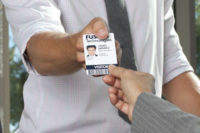Visitor management used to consist of a paper logbook at the reception desk. While this is still the case for many, particularly smaller facilities, more and more end users are entering the digital age when it comes to their visitors.
“More end users are looking to automate,” says Rick Focke, senior product manager, access control, building technologies and solutions, Johnson Controls, Westford, Mass. “There is more of a self-service mentality. It comes down to cost. They want to trim budgets while maintaining a good visitor experience, consolidate reception areas and do more things ahead of time. There may still be a person there, but there used to be three.”
Derek Arcuri, product manager for access control, Genetec, Montreal, adds, “I definitely see there is more of an adoption for the enhanced visitor management because of the benefits it has for the organization. When you are dealing with a lot of visitors, it is not only the operational efficiency, but that greeter at the front door doesn’t have to be constantly busy with visitors. The pre-visitor management can help them become not only more efficient but also more secure by running background checks.”
There will be opportunity out there for upgrades for the foreseeable future, whether that is with an independent stand-alone system, an integrated partnership or an embedded feature, says Steve Bardocz, president and CEO, Savance EIO Board, Commerce, Mich. Savance integrates with manufacturers such as Keri Systems, Brivo and others, he explains.
“I see there are still a lot of end users that are paper-based,” he says. “As more organizations move critical aspects to digital they realize there is this opportunity to move this, too. They start to think, ‘How am I going to muster if I have paper sheets?’ There are other decisions that drive that as well. I see the trend moving slower than we expected, to be honest. But I don’t think it is going to decline. As organizations move more into the digital realm and rely on other business needs like auditing, mustering or security, the visitor management starts to pick up.”
Integrators Dave Sweeney, COO, and John Gampp, chief engineer, Advantech, Dover, Del., have seen this as well. “We have seen an uptick in interest in visitor management from our customers over the last three or four years,” Sweeney says. “That can be attributed to a few different things. One, I believe the visitor management solutions have improved tremendously, so they are more feature-rich and user friendly. Another is the fact that our customers have gone and installed all the cameras and card readers they need. It is the next logical expenditure to improve physical security.”
Today's Visitor Management
There are three primary types of automated visitor management systems today: stand-alone systems sold through the channel or direct to the end user; third-party systems that have formed tight integrations with access control systems; and security manufacturers that have embedded visitor management or even separate systems that are designed to work seamlessly with their access control systems.
“It is tough to speak for others, but from my knowledge being in the industry, the majority of medium to large-sized companies have a similar approach to visitor management,” says end user Bret DuChateau, corporate security, Northwestern Mutual, Milwaukee. “Overall, companies more than ever want to know who is in, how often they are in, who is pre-registering. That starts changing behaviors, too, to help streamline processes at busy lobby desks. If you can predict that on Thursday one lobby will expect 200 people between 8:00 and 8:30 so you want to float an additional security person to help out, that improves the client experience as well.” DuChateau recently worked closely with Torrance, Calif.-based access control manufacturer AMAG to provide feedback on its revamped visitor management offering, Symmetry Guest. (See “Visitor Management: One End User’s Perspective” online at www.SDMmag.com/visitor-management-last-frontier.)
Focke notes a trend in recent years toward more self-service, whether that is a kiosk in the lobby or tablets or QR codes on the smartphone — similar to airport check-ins. “Traditionally visitor management had to be operated by a receptionist who then gave people cards, took a picture, scanned a driver’s license, etc. But now they are following the lead of airports. They are asking us for self-service, especially at remote or small sites. There may be one person handling 10 different buildings through network links and video displays.
“There is also a trend towards a wider range of credentials. That could be anything from a standard temporary badge to QR codes being emailed, to mobile credentials being provisioned ahead of time. The aim is to speed up the process when the visitor does arrive, so they have been pre-vetted and have their credential already.”
Phil Mantia, senior account manager, STOPware Inc., Pleasanton, Calif., notes that visitor management technology has changed in recent years. “The devices are different. A few years ago traditional visitor management was someone goes to a desk and a security person would register them. Now there are mobile devices, or kiosks. It is typical that it prints out a badge using the QR code, and we see a lot of customers now using the kiosk interface on the tablet as well.” The company’s PassagePoint solution integrates with many access control systems, he says.
It really boils down to the end user’s needs, Bardocz says. “If the need is very basic where it is no more than replacing a sign-in sheet and budget is an issue, the [typical] built-in visitor management will probably be the best bet. If you are looking for something that will be an integral part of your business and improve operations, you may want to upgrade to a more interactive visitor management system.”
Taking a different approach, HID, Austin, Texas, actually just added a new product to its EasyLobby offering, also aimed at making this transition easier. “EasyLobby Solo is a streamlined version designed to smooth the transition for small and large organizations moving from a traditional guest book to an automated, digital visitor management solution,” says Nils Walander, senior product marketing manager, HID Global. “In addition to facilitating a more professional image, organizations are able to increase security for visitors and employees by better managing who is entering and leaving the premises.”
While applications can range from the simple to the extremely complex, the key to any of them from the end user perspective is they must be simple to use, adds Jeff LeBlanc, vice president client services, AMAG Technology. “Providing an intuitive user interface and multiple ways to manage visitors is key to promoting buy-in within an organization. Calendar integration, access control integration, smartphone and tablet access, QR code and driver’s license scanners are all tools that help to simplify things.”
Game Changers
While there are many ways to provide visitor management today, there are some things beginning to change, from more use of the cloud and smartphones, to large manufacturers deciding to provide even more functionality to their embedded offerings.
Many of Genetec’s larger customers were asking them to add more visitor functionality, something the company is working toward launching sometime in the first quarter of 2018, Arcuri says. “We are a big advocate of the unified story and a lot of our customers were telling us they have to work with one of our partners to get this extended functionality, so where does the unified story stop? We looked at that and said there is a bigger adoption for identity and access management solutions. Let’s make that part of the experience.”
AMAG and Johnson Controls have also recently made significant efforts to enhance their visitor management offerings.
“In the last two years Software House has really upped our game in visitor management,” Focke says. “We offer, in my opinion, a very rich add-on to the system for visitors. It’s part of the native system, which offers the benefit of a common database, history log, interface, etc. It is not cloud-based now, but as our standard software moves to the cloud this will move as well.”
Cloud is another key factor, Mantia adds. “Cloud is becoming critical for access control and inherently for visitor management. There is the trend away from manned stations and more into a hybrid where you have a kiosk and limited interaction with the visitor.”
DuChateau appreciates that AMAG’s visitor management system is cloud-based. “Their system communicates with the access control system, which translates to we can provision this person access for this building and it does it instantly.”
Opportunity Knocks
Here is some advice for integrators on choosing and selling the right solution for your customer.
“The first thing anyone needs to know when selecting a visitor management system for a particular customer is what problems, policies and compliance needs the organization is facing today when it comes to processing visitors in their lobbies,” says AMAG Technology’s Jeff LeBlanc. “Sometimes integrators are more focused on the installation of the application and peripherals and the immediate problems the system will solve, but miss the analysis of an organization’s policies and ensuring the visitor management system can handle enforcing these policies.”
Johnson Control’s Rick Focke compares it to a good paint job. “The more prep work you do, the better the paint job. You want to keep it really simple for the actual visitors. Ask, ‘What are your requirements, Mr. end user? Which questions do you want to have asked to the visitor?’ Map it out ahead of time.”
He adds that there is a clear line of demarcation when it comes to the level of integration with the access control system.
Phil Mantia of STOPware says some integrators can underestimate visitor management. “Sometimes it is thought of as just a badge-making program, but maybe they want to send a credential to a phone, or notify the employee automatically or cross reference to a watch list. On a bad implementation these questions don’t get asked.”
Advantech’s Dave Sweeney says that as an integrator, visitor management is definitely an area of opportunity. “We deal with a lot of customers that have record-keeping requirements and believe it or not, the visitor log is the last thing that is still analog on paper. It is a wonderful opportunity to finish our customer’s conversion to a digital, paperless society.”
Checklist for Integrators
STOPware provides a global checklist to its integrators to help them better identify customers’ visitor management needs:
- How many users will be processing visitors?
- What type is your organization?
- Do you have a list of hosts you want to link to in real-time?
- Do you want employees to be able to pre-register visitors?
- Would you like all locations to be administered from one location?
- Do you need to give visitors access control cards?
- Do you require screening visitors against various registries?
- Do you require reading of PIV cards?
Visitor Management: One End User’s Perspective
For Northwestern Mutual, Milwaukee, visitor management had always been rather ad-hoc. That changed with the decision to add on to its downtown campus, and the opportunity to be part of a user group for a manufacturer that was looking to increase the functionality of its visitor management offering.
“We had just undertaken building on to our campus by connecting to a 32-story tower,” says Bret DuChateau, corporate security. “That was the driver to migrate away from paper credentials to a more formalized visitor management solution.
“We went from a couple of stand-alone systems that were run independently to making a strategic decision to go with an enterprise-class system about three years ago.”
DuChateau says working with AMAG Technology grew out of the company’s relationship with them for their access control system. “When we started discussions we knew they had a visitor management system that would suffice in the near term but we also knew they were working on Symmetry Guest as their cloud-based version. It was hugely advantageous for us to collaborate with them on system design and feature sets and be able to roll that out to our enterprise practically a year before opening the tower.”
The collaboration included giving feedback to the manufacturer, particularly about user friendliness and the overall experience for the user and the visitor, he adds. “We were able to give them real-life use cases such as ‘It would be nice if the system could do this or provide that. When you are at a lobby and 40 people walk up it would be nice if you can do rapid check-in, for example…. We have a lot of people that share admin responsibilities. What does that process look like for them? How logical is the system for me to register? All of those little things add up to being a really good end solution for companies.”
Now that the system is released, DuChateau says the relationship is ongoing. “We are still giving feedback. We are still on weekly calls and putting ideas on backlogs to be put in future releases.”






